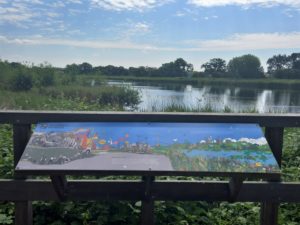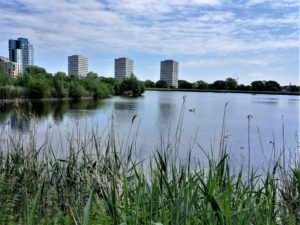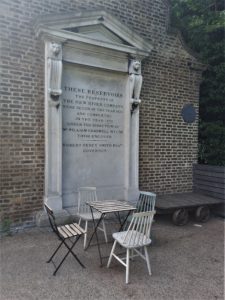During lockdown, we’ve walked to “Walthamstow Wetlands”:https://www.silvertraveladvisor.com/review/attraction/177606-review-walthamstow-wetlands more times than I care to remember. But recently I heard about “Woodberry Wetlands”:https://www.wildlondon.org.uk/woodberry-wetlands-nature-reserve which was only a short walk from Manor House Underground station (Piccadilly Line).
Exiting the station, we walked northwards up Green Lanes where we found, and followed, the narrow New River Path. The New River was as narrow as the path and in stretches full of reeds, but we saw lots of wildlife including a variety of ducks, many with fluffy babies, a wonderful heron perched on a branch and a swan guarding a nest of four huge eggs. Unfortunately, when the river went under the busy Seven Sisters Road, we had to divert from the path and cross using three sets of traffic lights.
Eventually the path looped back on itself, and we found the gates to the Wetlands which comprises of two large reservoirs: rather unimaginatively named, East and West. Although we’d hoped to take a path around the southern edge of East Reservoir, because of Covid, a one-way system was in operation and so we continued on the northern edge still on New River Path.
Unlike at Walthamstow Wetlands, there were seats dotted along the way, and several colourful information boards telling us about various aspects and the history of the reservoirs.
The artificial water body was dug out by hand by over 200 labourers using shovels and pickaxes in 1883, with the spoil creating the reservoir banks. It was designed to store drinking water, but from the early 1900s, with more people living in the neighbourhood, chlorine and ammonia were added to clean the water and prevent freshwater mussels growing and blocking up water pipes: however, the process also killed off almost all the wildlife. Chemical usage was stopped in the 1970s and the raw water is now treated at Coppermill filter beds in Walthamstow. So, the reservoir remains a source of London’s drinking water and is operated by Thames Water. At its deepest point the reservoir is over 3 meters deep, and holds one 150,000 cubic meters of water, enough to supply only 11 hours of tap water to Greater London.
Large areas of reedbeds have been created around the water’s edge to provide a home and food for birds such as Reed Warbler and Reed Bunting and other animals such as bats, bees and dragon flies.
We eventually came to the Coal House Café where there were a number of tables and chairs outside overlooking the reservoir. A large limestone plaque commemorates this feat of engineering and we learned that there were originally three buildings, including a boiler pump house, but now only the Coal House remains. It once contained a large kitchen and fireplace, used to supply food to a dining hall used by the New River Company directors for lunch meetings.
Having reached the café, which we didn’t use, we appeared to be in a Covid one-way system, and the only route was to continue to circumnavigate the east reservoir, which meant retracing some of our steps on the northern shore. However, it gave us chance to see conservation volunteers in action, appreciate the views from different angles and spot a roaming urban fox.
One information board explained how the surrounding area has transformed over the last 600 years from being a wooded landscape, where wild deer and boar roamed and the Duke of Northumberland hunted, through to being the wealthy London suburb of Woodberry Down in the 1900s with mansions with huge gardens backing onto the New River. Albert Chevalier, a famous entertainer of the time, lived at Lake House and was buried at nearby “Abney Park Cemetery”:https://www.silvertraveladvisor.com/review/attraction/205793-review-abney-park. In the late 1930s London County Council compulsory purchased and demolished these houses to build a modern housing estate. New homes were needed for people living in the crowded and insanitary tenement blocks of east London, which had been damaged during the Second World War. It was known in the 1950s as the “estate of the future” and at that time was one of the largest housing developments in Europe.
Today, the Woodberry Down area is undergoing further major regeneration and as we continued walking the New River Path along the West Reservoir, we saw large, swish apartment blocks for sale and yachts and canoes moored up at the “West Reservoir Centre”:https://www.better.org.uk/leisure-centre/london/hackney/west-reservoir-centre?utm_source=google&utm_medium=organic&utm_campaign=google_my_business. Just before we exited the path back onto the main road, Green Lanes, we saw a middle-aged man paddling in the shallow river, trying unsuccessfully to coax his obviously non-swimming dog into the water. A perfect end to a lovely walk.










